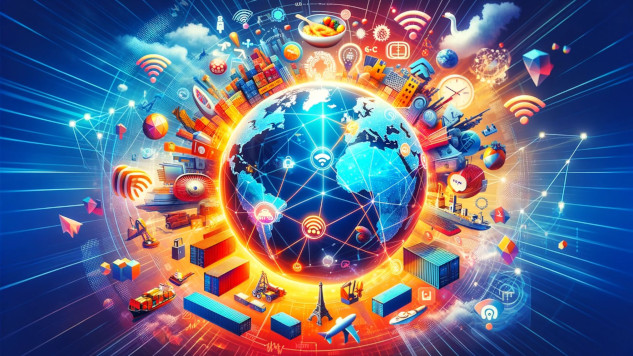
In This Article:
- How did ancient trade routes shape early global commerce?
- What role did wars and political changes play in disrupting global trade?
- How did the Industrial Revolution accelerate global trade growth?
- The impact of neoliberal policies on the modern global economy.
- How does globalization affect income inequality and political stability?
- What lessons can we learn from the rise and fall of economic policies throughout history?
The Evolution of Global Trade: From Ancient Routes to Modern Inequality
by Robert Jennings, Innerself.com
Globalization, a phenomenon centuries in the making, has shown remarkable resilience, weaving through ancient trade routes like the Silk Road. This network, where goods, ideas, and cultures merged across continents, was a testament to the enduring spirit of trade. From the bustling markets of the Mediterranean to the far reaches of the Indian Ocean, trade fueled economies and shaped societies and empires. The evolution continued with the age of exploration and colonial dominance, followed by the Industrial Revolution, which accelerated global commerce to new heights.
Yet, globalization's path has been anything but linear, marked by growth cycles, conflict, and upheaval. Wars, economic collapses, and political shifts have disrupted trade, reshaped global policies, and redefined power dynamics. But the global economy has bounced back each time, demonstrating its resilience and adaptability.
The transformative events of the 20th century, particularly the devastation of two world wars and the economic turmoil of the Great Depression, set the stage for a new world order. The United States and Canada emerged uniquely positioned in the post-war world, largely spared from the physical destruction faced by Europe and Asia. This gave them the advantage to drive global economic recovery, ushering in a resurgence of trade that would dominate the latter half of the century.
However, inequality surged as we transitioned into an era defined by neoliberal policies, a set of economic policies that advocate for free markets, deregulation and privatization, and corporate expansion, particularly in the United States. The story of globalization is thus a narrative of relentless change, where economic policies, technological advancements, and social upheavals continue to shape our interconnected world.
Early Beginnings of Global Trade
Trade between civilizations has been the bedrock of economic exchange since ancient times. The Silk Road was among the most significant, facilitating trade between the East and the West and linking China, India, Persia, and the Roman Empire. Along this vast network, silk, spices, precious metals, and ideas flowed, creating a vibrant cultural and economic exchange.
Similarly, Indian Ocean trade connected East Africa, the Middle East, and Asia, becoming a hub for exchanging textiles, spices, and metals. Meanwhile, Mediterranean trade routes saw the Phoenicians, Greeks, and Romans navigating sea routes to trade goods, laying the foundation for economic integration in ancient Europe.
During the Age of Exploration (15th—17th century), European explorers such as Columbus, Vasco da Gama, and Magellan opened up new trade routes across the Atlantic and Pacific. This era marked the beginning of global maritime commerce and established colonial empires. Portuguese and Spanish dominance in the Americas, Africa, and Asia initiated a new wave of international trade and resource extraction.
Soon, the Dutch and British emerged as maritime powers, further expanding global commerce. The rise of joint-stock companies like the British East India Company facilitated trade and extended colonial control, beginning a more structured and capital-intensive approach to international trade.
Globalization in the Pre-WWI Era
The Industrial Revolution was a game-changer for global trade, transforming production and increasing demand for raw materials and new markets. Technological advancements, such as the steam engine, revolutionized goods transport, allowing for faster and cheaper global trade. These innovations linked distant markets and fostered the exchange of goods on an unprecedented scale.
This era also witnessed the emergence of global financial integration through the Gold Standard, which stabilized currencies and facilitated international trade. The role of these technological advancements in facilitating global trade cannot be overstated, as they not only accelerated the pace of commerce but also brought distant markets within reach, fostering a truly global economy.
Like the Cobden–Chevalier Treaty (1860), free trade policies they have fostered trade integration in Europe. Global capital flows surged as European investors financed infrastructure projects in Latin America, Africa, and Asia, integrating these regions into the global economy.
Mass migration from Europe to the Americas, Australia, and other colonies created labor markets for developing industries and expanded global trade networks. European empires used colonial exploitation to expand trade, extracting raw materials to fuel industrial growth back home. However, these economic gains came at the cost of exploitation and inequality, sowing seeds of future economic and political tensions.
Massive Disruption: World War I, the Great Depression, and World War II
However, beneath this surface of prosperity, political tensions and competition for colonial dominance were brewing, ultimately igniting the conflict that would bring this wave of globalization to a crashing halt. This interconnectedness underscores the significance of each individual's role in the global economy, as every trade and investment has the potential to shape the world we live in.
The outbreak of World War I shattered this interconnected world. Suddenly embroiled in a total war, nations shifted their economies from peacetime production to war efforts, drastically reducing international trade. Tariffs were imposed, and countries began hoarding resources to support their military needs, leading to a severe collapse in global commerce. The abandonment of the Gold Standard created financial instability, as countries could no longer rely on a fixed exchange rate system to stabilize their currencies.
Post-war, Europe was left in economic ruins, with Germany facing crippling reparations that further destabilized the global economy. The once fluid movement of goods, people, and capital ground to a halt, and the economic fragility that followed laid the groundwork for even more significant upheavals, setting the stage for the Great Depression and another devastating world war.
The Great Depression was a cataclysmic economic collapse that began with the 1929 stock market crash in the United States, sending shockwaves through the global financial system. In an era when the world had become increasingly interconnected through trade and investment, the collapse of U.S. markets triggered a domino effect, causing banks to fail and businesses to close not just in America but across Europe, Latin America, and beyond.
As banks tightened credit, international trade plummeted, leading to a drastic fall in industrial production and widespread unemployment. The economic fallout exposed the fragility of the global economy, which had grown too dependent on a handful of powerful nations and their interconnected markets. This economic downturn highlighted the global economy's interconnectedness and the need for a more balanced and diversified financial system.
In response to the economic crisis, countries turned inward, adopting protectionist policies that worsened the situation. One of the most significant was the U.S. Smoot-Hawley Tariff Act of 1930, which raised tariffs on thousands of imported goods to protect domestic industries. Other nations retaliated with their tariffs, leading to a sharp contraction in global trade. The collapse of economic cooperation and the rise of protectionism deepened the depression, undermining international trust and cooperation.
Nationalism surged as governments focused on internal stability, often blaming foreign entities for their economic woes. This climate of financial despair and rising nationalism set the stage for political extremism and conflict, creating fertile ground for the authoritarian regimes that would soon plunge the world into World War II.
World War II unleashed an unprecedented level of destruction that crippled the global economy, particularly in Europe and Asia. Cities were reduced to rubble, vital infrastructure was obliterated, and entire industries were either confiscated for the war effort or decimated by relentless bombings. In countries like Germany, Japan, France, and the United Kingdom, factories, railways, and ports lay in ruins, leaving economies shattered and populations struggling to rebuild amidst the wreckage.
In stark contrast, the United States and Canada, shielded by the vast oceans on either side, experienced no direct battles on their soil. This geographic insulation allowed their economies to remain intact and thrive during the war. With Europe and Asia engulfed in conflict, the U.S. and Canada became the primary suppliers of Allied forces' weapons, vehicles, food, and other essential goods.
This demand spurred a wartime industrial boom, resulting in total employment, technological advancements, and a significant expansion of their economic power. By the war's end, these two nations stood poised to dominate the post-war global economy. At the same time, the rest faced the daunting task of reconstruction.
In the 1930s, Franklin D. Roosevelt's New Deal reshaped the American economy and society, introducing a series of bold reforms designed to lift the country out of the Great Depression. Through extensive social welfare programs, infrastructure investment, and labor rights protections, the New Deal aimed to provide immediate relief, create jobs, and stimulate economic recovery.
Programs like the Works Progress Administration (WPA) and the Civilian Conservation Corps (CCC) built roads, schools, and hospitals and restored hope to millions of unemployed Americans. Policies such as Social Security and labor rights reforms laid the foundation for a more equitable society. These initiatives did more than transform the U.S.; they served as a blueprint for post-war reconstruction efforts in Europe and Japan. Following the devastation of World War II, war-torn countries adopted similar government-led interventions to rebuild their economies and societies.
Marshall Plan aid, modeled on New Deal principles, helped reconstruct European infrastructure. At the same time, Japan's government-directed economic policies mirrored New Deal-style strategies. Thus, Roosevelt's vision provided a framework that revitalized the U.S. during its crisis and guided global recovery and development in the aftermath of the war.
The Post-WWII Resurgence of Globalization
The Bretton Woods Agreement, established in 1944 as World War II neared its end, laid the foundation for a new era of international financial cooperation and economic stability. Recognizing the need to prevent the economic turmoil that had led to the Great Depression and the war, delegates from 44 Allied nations gathered in Bretton Woods, New Hampshire, to create a monetary system that would facilitate global trade and rebuild war-ravaged economies.
The agreement pegged currencies to the U.S. dollar, which was convertible to gold, providing a fixed exchange rate system to stabilize global markets. This framework also led to the creation of critical financial institutions: the International Monetary Fund (IMF) and the World Bank. The IMF was designed to monitor exchange rates, provide financial assistance to countries facing balance of payments crises, and ensure a stable international monetary system.
Meanwhile, the World Bank focused on funding the reconstruction of Europe and the development of poorer nations through long-term capital investments. These institutions fostered an environment where international trade could flourish again, laying the groundwork for decades of economic growth and integration. The Bretton Woods system thus marked a turning point, setting up rules and mechanisms that would shape the global economy for years to come.
In the aftermath of World War II, the United States took a leading role in reviving the global economy, mainly through the Marshall Plan in Europe and its involvement in Japan's reconstruction. The Marshall Plan, officially known as the European Recovery Program, saw the U.S. providing over $13 billion (approximately $150 billion today) in economic assistance to help rebuild war-torn European countries, restore infrastructure, and revive industries. This infusion of capital staved off the threat of financial collapse.
It fostered political stability, creating a fertile trade and economic integration environment. Simultaneously, the U.S. directed efforts to rebuild Japan, transforming it from a war-ravaged nation into an industrial powerhouse. With U.S. aid, Japan focused on technological innovation, industrial policy, and strategic investments in electronics and automotive manufacturing, leading to its "economic miracle." During this period, U.S. multinational corporations (MNCs) such as Coca-Cola, IBM, and Ford expanded their global reach, setting up operations abroad and creating complex supply chains that spanned continents.
These MNCs not only fueled global consumerism but also facilitated the integration of international markets, cementing the foundations of the modern global economy. The combined impact of U.S. aid and investment in Europe and Japan laid the groundwork for decades of economic growth, trade, and cooperation.
During the Cold War, the United States positioned itself as the champion of capitalism and free markets to counter the spread of Soviet communism, using economic influence as a vital tool in this ideological battle. Through a combination of strategic aid, investment, and trade policies, the U.S. aimed to promote economic development and political stability in regions such as Western Europe, South Korea, and Latin America.
In Western Europe, the Marshall Plan's success spurred economic recovery and created a bulwark against communist ideologies by demonstrating the benefits of a market-driven economy. In Asia, U.S. support for South Korea's industrialization and land reforms helped transform it into a capitalist economic powerhouse, showcasing the prosperity achievable under a free-market system. Latin America, too, became a focal point of U.S. economic policy, with initiatives such as the Alliance for Progress providing economic assistance to counter leftist movements.
To facilitate global trade and strengthen alliances, the U.S. also played a central role in establishing the General Agreement on Tariffs and Trade (GATT), which promoted the reduction of trade barriers and the integration of Western economies. This network of trade agreements spurred economic growth among capitalist nations. It deepened economic interdependence, creating a powerful counter-narrative to the Soviet model and setting the stage for the later expansion of globalization.
The Neoliberal Revolution: 1980s and Beyond
In the 1980s, the political and economic landscapes of the United States and the United Kingdom were transformed by the rise of neoliberal policies under the leadership of Ronald Reagan and Margaret Thatcher. Rejecting the post-war consensus of government intervention and welfare states, both leaders championed a new approach emphasizing deregulation, privatization, and tax cuts as the path to economic growth and prosperity.
In the U.S., Reagan's administration implemented sweeping tax reforms, reducing corporate and income taxes to encourage investment while slashing government regulations that were seen as impediments to business. Similarly, in the U.K., Thatcher's government embarked on an aggressive campaign to privatize state-owned industries, from utilities to transportation, arguing that market forces could better allocate resources than the public sector.
These neoliberal policies supercharged globalization by promoting free markets and encouraging the liberalization of global finance, allowing capital to move across borders with unprecedented ease. The reduction of trade barriers and the push for open markets provided multinational corporations with new expansion opportunities, leading to the growth of global supply chains and corporate dominance in industries ranging from manufacturing to technology. The result was a period of rapid economic integration and development, the onset of rising inequality, and a weakening of labor protections, consequences that would reverberate into the following decades.
Modern Globalization and Its Discontents
The deregulation of financial markets in the late 20th century was crucial in accelerating globalization and reshaping global economic dynamics. Financial liberalization allowed capital to move across borders more freely, leading to the rise of international financial institutions and investment in emerging markets. This increase in capital mobility encouraged the growth of multinational corporations and facilitated the expansion of global supply chains.
At the same time, trade agreements like the North American Free Trade Agreement (NAFTA) and the establishment of the World Trade Organization (WTO) were hailed as breakthroughs that would usher in an era of increased trade, economic growth, and international cooperation. These agreements integrated global economies more tightly by reducing tariffs and trade barriers, enabling businesses to source cheaper labor and materials worldwide. While this approach expanded corporate profits and consumer access to a broader array of goods, it also introduced significant economic shifts that left many workers vulnerable, particularly in developed countries.
The Digital Revolution, marked by the rapid development of the internet and digital technologies, has dramatically accelerated global trade, communication, and economic integration. It transformed how businesses operate, enabling companies to connect with consumers and suppliers worldwide quickly and efficiently.
This shift gave rise to tech giants like Google, Amazon, and Apple, which quickly expanded their reach to dominate various sectors of the global economy, from e-commerce and digital advertising to cloud computing and entertainment. These corporations reshaped traditional business models, introduced new forms of commerce such as online marketplaces and digital services, and facilitated the seamless flow of information and goods across borders. However, this digital transformation has also raised complex issues regarding data privacy, with companies collecting vast amounts of personal information, often with minimal oversight or regulation.
Additionally, these tech giants' sheer scale and influence have sparked concerns about monopoly power, as their market dominance stifles competition and innovation. Labor practices within the digital economy, such as the gig economy and warehouse employment, have come under scrutiny as well, with debates around fair wages, workers' rights, and job security in a landscape increasingly shaped by automation and artificial intelligence. Thus, while the Digital Revolution has propelled global connectivity and economic growth, it has also introduced new challenges that societies must address to ensure a more equitable and ethical digital future.
The Consequences of Globalization
Financial liberalization and free trade benefits were unevenly distributed, increasing wealth inequality. As corporations pursued cost-cutting measures and relocated manufacturing jobs to countries with cheaper labor, workers in industrialized nations, particularly in sectors like manufacturing and textiles, found themselves increasingly displaced.
Governments in countries like the United States must implement adequate support systems to help these workers transition into new industries. Policies that might have softened the blow, such as retraining programs, educational subsidies, and stronger social safety nets, were either underfunded or absent.
Additionally, deregulation efforts, corporate tax cuts, and the decline of labor unions weakened workers' bargaining power, resulting in stagnant wages and deteriorating job security for the middle and working classes. As companies expanded their global operations, the wealth generated from these activities increasingly flowed to the top, deepening the wealth gap and leaving many feeling left behind.
The political fallout from this growing economic inequality and government inaction became evident in the early 21st century. Displaced workers and those experiencing financial hardship due to job losses and wage stagnation began to express their dissatisfaction through political movements. In the U.S., anger and frustration over economic policies culminated in the emergence of the Tea Party. This conservative movement opposed government intervention and tax policies perceived as unfair.
Later, these sentiments were harnessed by the "Make America Great Again" (MAGA) movement and the election of Donald Trump, whose presidency capitalized on the grievances of those marginalized by globalization. Trump's anti-establishment rhetoric, promises to renegotiate trade deals, and calls to bring back manufacturing jobs resonated with a large population that viewed free trade agreements like NAFTA and institutions like the WTO as direct contributors to their economic plight.
The failure of governments to support and protect those displaced by globalization thus played a pivotal role in the political upheavals that continue to shape the current global landscape.
Biden's Economic Policies and the Future of Globalization
President Joe Biden's initial agenda marked a clear shift away from the neoliberal policies that had dominated the U.S. economic landscape for decades. His administration prioritized infrastructure investment by passing the Infrastructure Investment and Jobs Act, aiming to modernize the nation's roads, bridges, and public transit systems while creating millions of jobs.
Additionally, Biden sought to address income inequality through tax reform, proposing higher taxes on corporations and the wealthy to fund programs that benefit working families, including expanded child tax credits and healthcare support. On the social welfare front, his American Rescue Plan injected direct relief to millions of Americans, expanded unemployment benefits, and provided aid to struggling small businesses.
However, as the 2024 election approached, Biden chose not to seek re-election, endorsing Vice President Kamala Harris and her running mate, Tim Walz, the Governor of Minnesota. Harris and Walz represent a continuation of Biden's efforts, focusing on building a fairer economy, addressing climate change through green infrastructure investment, and advancing policies to reduce economic disparities. Their platform suggests an intent to carry forward and expand upon the work Biden started, signaling a sustained effort to challenge the excesses of neoliberalism and pursue a more inclusive economic future.
A Harris-Walz administration holds the potential to build upon and significantly expand the policies initiated under President Biden, with a central focus on economic equity, climate action, and strategic investment in green energy and infrastructure. Vice President Kamala Harris has long advocated for progressive tax reforms, emphasizing the need to address rising inequality by ensuring that corporations and the wealthiest individuals contribute much to the nation's economy. Her plans include closing tax loopholes that benefit the ultra-rich, increasing taxes on large corporations, and using the revenue to bolster social programs, healthcare, and education for the middle and working classes.
As Governor of Minnesota, Tim Walz has a track record of implementing FDR-style reforms, demonstrating a commitment to public investment, social welfare, and strengthening labor rights. His experience includes expanding healthcare access, investing in renewable energy projects, and advocating for increased public education and infrastructure funding—all priorities aligning with Harris's economic and social agenda.
Together, their administration would likely pursue ambitious climate policies, including large-scale green infrastructure projects and a transition to renewable energy sources, aiming to combat climate change, generate jobs, and stimulate economic growth. This combination of policies underscores a vision for a robust, forward-looking, just, and inclusive economy.
The U.S. faces numerous political and economic challenges as it attempts to balance domestic priorities with its role in a globalized world. Navigating the complex interplay between promoting economic equity, addressing climate change, and managing international trade will define the future trajectory of globalization.
The history of global trade reveals a cyclical pattern of growth, disruption, and resurgence. Modern challenges, including inequality, climate change, and social justice, echo those of past eras. As globalization continues to evolve, thoughtful reforms are necessary to ensure that global trade benefits more than just the elite. By prioritizing equity and sustainability, we can create a more inclusive and equitable global economy that serves the well-being of all.
Article Recap:
This article explores the history of global trade, from ancient routes to modern markets. It examines the effects of globalization on economies, highlighting pivotal moments like the Industrial Revolution, world wars, and the rise of neoliberal policies. By understanding this history, we can grasp how globalization continues to shape economic opportunities and challenges today.
About the Author
 Robert Jennings is co-publisher of InnerSelf.com with his wife Marie T Russell. He attended the University of Florida, Southern Technical Institute, and the University of Central Florida with studies in real estate, urban development, finance, architectural engineering, and elementary education. He was a member of the US Marine Corps and The US Army having commanded a field artillery battery in Germany. He worked in real estate finance, construction and development for 25 years before starting InnerSelf.com in 1996.
Robert Jennings is co-publisher of InnerSelf.com with his wife Marie T Russell. He attended the University of Florida, Southern Technical Institute, and the University of Central Florida with studies in real estate, urban development, finance, architectural engineering, and elementary education. He was a member of the US Marine Corps and The US Army having commanded a field artillery battery in Germany. He worked in real estate finance, construction and development for 25 years before starting InnerSelf.com in 1996.
InnerSelf is dedicated to sharing information that allows people to make educated and insightful choices in their personal life, for the good of the commons, and for the well-being of the planet. InnerSelf Magazine is in its 30+year of publication in either print (1984-1995) or online as InnerSelf.com. Please support our work.
Creative Commons 4.0
This article is licensed under a Creative Commons Attribution-Share Alike 4.0 License. Attribute the author Robert Jennings, InnerSelf.com. Link back to the article This article originally appeared on InnerSelf.com
Recommended books:
Capital in the Twenty-First Century
by Thomas Piketty. (Translated by Arthur Goldhammer)
 In Capital in the Twenty-First Century, Thomas Piketty analyzes a unique collection of data from twenty countries, ranging as far back as the eighteenth century, to uncover key economic and social patterns. But economic trends are not acts of God. Political action has curbed dangerous inequalities in the past, says Thomas Piketty, and may do so again. A work of extraordinary ambition, originality, and rigor, Capital in the Twenty-First Century reorients our understanding of economic history and confronts us with sobering lessons for today. His findings will transform debate and set the agenda for the next generation of thought about wealth and inequality.
In Capital in the Twenty-First Century, Thomas Piketty analyzes a unique collection of data from twenty countries, ranging as far back as the eighteenth century, to uncover key economic and social patterns. But economic trends are not acts of God. Political action has curbed dangerous inequalities in the past, says Thomas Piketty, and may do so again. A work of extraordinary ambition, originality, and rigor, Capital in the Twenty-First Century reorients our understanding of economic history and confronts us with sobering lessons for today. His findings will transform debate and set the agenda for the next generation of thought about wealth and inequality.
Click here for more info and/or to order this book on Amazon.
Nature's Fortune: How Business and Society Thrive by Investing in Nature
by Mark R. Tercek and Jonathan S. Adams.
 What is nature worth? The answer to this question—which traditionally has been framed in environmental terms—is revolutionizing the way we do business. In Nature’s Fortune, Mark Tercek, CEO of The Nature Conservancy and former investment banker, and science writer Jonathan Adams argue that nature is not only the foundation of human well-being, but also the smartest commercial investment any business or government can make. The forests, floodplains, and oyster reefs often seen simply as raw materials or as obstacles to be cleared in the name of progress are, in fact as important to our future prosperity as technology or law or business innovation. Nature’s Fortune offers an essential guide to the world’s economic—and environmental—well-being.
What is nature worth? The answer to this question—which traditionally has been framed in environmental terms—is revolutionizing the way we do business. In Nature’s Fortune, Mark Tercek, CEO of The Nature Conservancy and former investment banker, and science writer Jonathan Adams argue that nature is not only the foundation of human well-being, but also the smartest commercial investment any business or government can make. The forests, floodplains, and oyster reefs often seen simply as raw materials or as obstacles to be cleared in the name of progress are, in fact as important to our future prosperity as technology or law or business innovation. Nature’s Fortune offers an essential guide to the world’s economic—and environmental—well-being.
Click here for more info and/or to order this book on Amazon.
Beyond Outrage: What has gone wrong with our economy and our democracy, and how to fix it -- by Robert B. Reich
 In this timely book, Robert B. Reich argues that nothing good happens in Washington unless citizens are energized and organized to make sure Washington acts in the public good. The first step is to see the big picture. Beyond Outrage connects the dots, showing why the increasing share of income and wealth going to the top has hobbled jobs and growth for everyone else, undermining our democracy; caused Americans to become increasingly cynical about public life; and turned many Americans against one another. He also explains why the proposals of the “regressive right” are dead wrong and provides a clear roadmap of what must be done instead. Here’s a plan for action for everyone who cares about the future of America.
In this timely book, Robert B. Reich argues that nothing good happens in Washington unless citizens are energized and organized to make sure Washington acts in the public good. The first step is to see the big picture. Beyond Outrage connects the dots, showing why the increasing share of income and wealth going to the top has hobbled jobs and growth for everyone else, undermining our democracy; caused Americans to become increasingly cynical about public life; and turned many Americans against one another. He also explains why the proposals of the “regressive right” are dead wrong and provides a clear roadmap of what must be done instead. Here’s a plan for action for everyone who cares about the future of America.
Click here for more info or to order this book on Amazon.
This Changes Everything: Occupy Wall Street and the 99% Movement
by Sarah van Gelder and staff of YES! Magazine.
 This Changes Everything shows how the Occupy movement is shifting the way people view themselves and the world, the kind of society they believe is possible, and their own involvement in creating a society that works for the 99% rather than just the 1%. Attempts to pigeonhole this decentralized, fast-evolving movement have led to confusion and misperception. In this volume, the editors of YES! Magazine bring together voices from inside and outside the protests to convey the issues, possibilities, and personalities associated with the Occupy Wall Street movement. This book features contributions from Naomi Klein, David Korten, Rebecca Solnit, Ralph Nader, and others, as well as Occupy activists who were there from the beginning.
This Changes Everything shows how the Occupy movement is shifting the way people view themselves and the world, the kind of society they believe is possible, and their own involvement in creating a society that works for the 99% rather than just the 1%. Attempts to pigeonhole this decentralized, fast-evolving movement have led to confusion and misperception. In this volume, the editors of YES! Magazine bring together voices from inside and outside the protests to convey the issues, possibilities, and personalities associated with the Occupy Wall Street movement. This book features contributions from Naomi Klein, David Korten, Rebecca Solnit, Ralph Nader, and others, as well as Occupy activists who were there from the beginning.
Click here for more info and/or to order this book on Amazon.






























